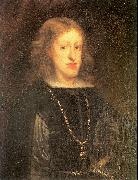Wholesale Oil Painting No Minimum |
|||||||||||
|
|
|||||||||||

|
|||||||||||
|
|
|
||||||||
Miranda, Juan Carreno deSpanish, 1614-1685 was a Spanish painter of the Baroque period. Born in Avil's in Asturias, son of a painter with the same name, Juan Carreño de Miranda. His family moved to Madrid in 1623, and he trained in Madrid during the late 1620s as an apprentice to Pedro de Las Cuevas and Bartolom Roman. He came to the notice of Velezquez for his work in the cloister of Doña Maria de Aragen and in the church of El Rosario. In 1658 Carreño was hired as an assistant on a royal commission to paint frescoes in the Alcezar palace, now the Royal Palace of Madrid. In 1671, upon the death of Sebastian de Herrera, he was appointed court painter to the queen (pintor de cemara) and began to paint primarily portraits. He refused to be knighted in the order of Santiago, saying Painting needs no honors, it can give them to the whole world. He is mainly recalled as a painter of portraits. His main pupils were Mateo Cerezo, Cabezalero, Donoso, Ledesma y Sotomayor. He died in Madrid. Noble by descent, he had an understanding of the workings and psychology of the royal court as no painter before him making, his portraits of the Spanish royal family in an unprecedented documentary fashion |
||||||||
|
|
||||||||
Portrait of Charles II
Portrait of Charles II Painting ID:: 19455 |
1676
Oil on canvas
Museo del Prado, Madrid. 1676 Oil on canvas Museo del Prado, Madrid. |
|||||||
|
|
||||||||
|
Miranda, Juan Carreno de Spanish, 1614-1685 was a Spanish painter of the Baroque period. Born in Avil's in Asturias, son of a painter with the same name, Juan Carreño de Miranda. His family moved to Madrid in 1623, and he trained in Madrid during the late 1620s as an apprentice to Pedro de Las Cuevas and Bartolom Roman. He came to the notice of Velezquez for his work in the cloister of Doña Maria de Aragen and in the church of El Rosario. In 1658 Carreño was hired as an assistant on a royal commission to paint frescoes in the Alcezar palace, now the Royal Palace of Madrid. In 1671, upon the death of Sebastian de Herrera, he was appointed court painter to the queen (pintor de cemara) and began to paint primarily portraits. He refused to be knighted in the order of Santiago, saying Painting needs no honors, it can give them to the whole world. He is mainly recalled as a painter of portraits. His main pupils were Mateo Cerezo, Cabezalero, Donoso, Ledesma y Sotomayor. He died in Madrid. Noble by descent, he had an understanding of the workings and psychology of the royal court as no painter before him making, his portraits of the Spanish royal family in an unprecedented documentary fashion Portrait of Charles II mk61 c.1676 Oil on canvas 201x141cm |
||||||||
|
|
||||||||
|
Prev Next
|
||||||||
|
|
||||||||
|
Related Paintings to Miranda, Juan Carreno de :. |
||||||||
|
|
||||||||
|
CONTACT US |

